Le vice-amiral Horatio Nelson, 1er vicomte Nelson, dit Lord Nelson
5 participants
LE FORUM DE MARIE-ANTOINETTE :: La famille royale et les contemporains de Marie-Antoinette :: Autres contemporains : les hommes du XVIIIe siècle
Page 3 sur 3
Page 3 sur 3 •  1, 2, 3
1, 2, 3

Comtesse Diane- Messages : 7397
Date d'inscription : 21/12/2013
Localisation : TOURAINE
 Horation Nelson Armorial
Horation Nelson Armorial
Le 18 janvier prochain, la maison Sotheby's Londres proposera, en vente aux enchères, de nombreux lots liés au célèbre héros national anglais...
Dommage, mon père Noël est déjà passé, et il est ruiné !
 Et parmi ces nombreux lots historiques :
Et parmi ces nombreux lots historiques :
ARMORIAL ACHIEVEMENT - Lord Horatio Nelson
By Nayler, George
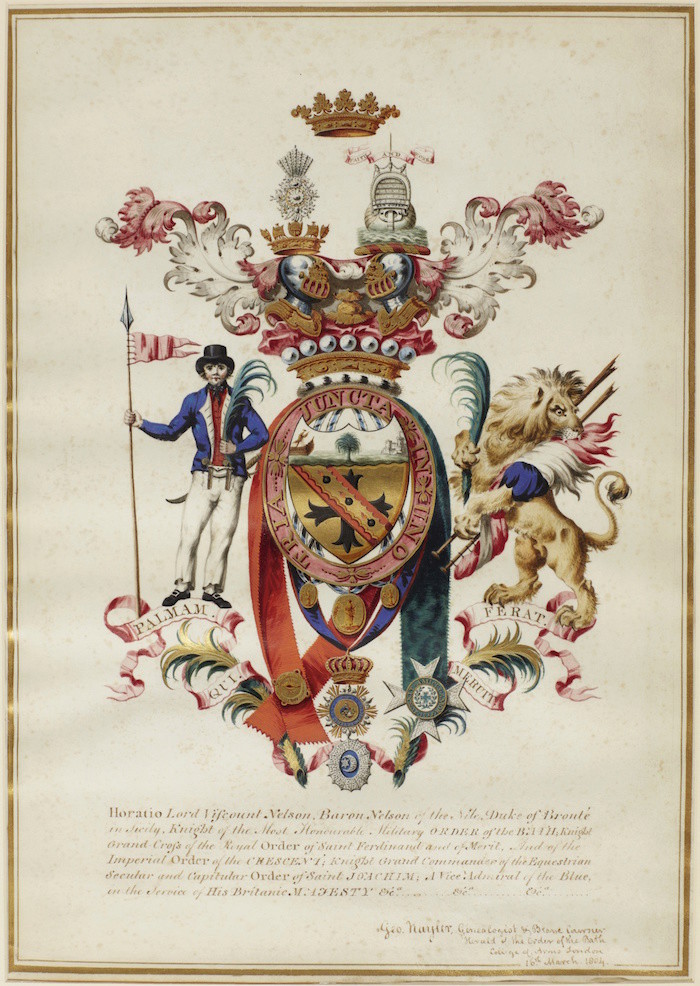
Finely illuminated and heightened in gilt, subscribed with Nelson's titles and honours ("Horatio Lord Viscount Nelson, Baron Nelson of the Nile, Duke of Bronte on Sicily, Knight of the Most Honourable Military Order of the Bath [...] Vice Admiral of the Blue [etc]..."), one vellum membrane (435 x 375mm)
Signed and dated by Nayler as Blane Coursier Herald and Genealogist of the Order of the Bath, College of Arms, 16 March 1804.

Photo : Sotheby's
Extrait de la note de l'expert
A l'attention spéciale de notre généalogiste et expert en héraldique du forum :
:
Nelson's arms were a cross fleury sable, a bend gules, surmounted by another engrailed of the field, charged with three bombs, fired proper, augmented after the Nile (as here) with a chief undulated, argent, thereon waves of the sea, from which a palm tree issuant, between a disabled ship on the dexter and a ruinous battery on the sinister.
He chose as his supporters (who after the Nile bore palm leaves) dexter a sailor armed with a cutlass and pair of pistols supporting a staff thereon hoisted a Commodore's flag gules, sinister a lion rampant in his mouth a broken flag-staff, a tri-coloured flag in his mouth. The arms bear a Viscount's coronet (his English title taking precedence over his Sicilian Dukedom).
The crests of the two helms are, dexter, the Chelengk, or plume of triumph, given to Nelson by the Ottoman Sultan after the Battle of the Nile, and sinister, the stern of a ship inscribed "San Josef", the Spanish battleship he took at the Battle of Cape St Vincent.
His motto, "Palmam qui meruit ferat" [Let he who has earned it take the palm], was also granted after the Nile.
Finally, the achievement includes the insignia of the orders of honour conferred on Nelson: the Bath, the Sicilian Order of St Ferdinand and of Merit, the Ottoman Order of the Cresent, and the Germanic Order of St Joachim.
 En effet, nous remarquons, à gauche, vers le sommet de son blason, la célèbre décoration "Chelengk", évoquée récemment dans ce sujet-ci (voir pages précédentes) :
En effet, nous remarquons, à gauche, vers le sommet de son blason, la célèbre décoration "Chelengk", évoquée récemment dans ce sujet-ci (voir pages précédentes) :

Suite de la note de l'expert :
The herald George Nayler (1764-1831), had worked closely with Nelson in the original design of his arms and was later to serve as one of the three officials who were deputed by the Admiralty to receive Nelson's body from the Victory.
The original purpose of this splendid document is not known but it may have been intended for the heralds of Sicily.
Nelson had written to Nayler on 19 October 1803 :
"I have sent to Sicily for the Arms of Bronté, and the Heralds College there has sent for my English Arms, in order that they may be enrolled amongst those of the Sicilian Nobility ; therefore you will be so good as to send me out the same sort of thing which I sent to Germany.
I very much doubt that I ever paid for that, and several other things which you have done for me; therefore, I desire (for in a man's trade there are no compliments) that you will send me out your regular bill, for I suppose you cannot live upon air ; and if you are never paid, how is the pot to boil ?...
; and if you are never paid, how is the pot to boil ?...
Dommage, mon père Noël est déjà passé, et il est ruiné !

ARMORIAL ACHIEVEMENT - Lord Horatio Nelson
By Nayler, George

Finely illuminated and heightened in gilt, subscribed with Nelson's titles and honours ("Horatio Lord Viscount Nelson, Baron Nelson of the Nile, Duke of Bronte on Sicily, Knight of the Most Honourable Military Order of the Bath [...] Vice Admiral of the Blue [etc]..."), one vellum membrane (435 x 375mm)
Signed and dated by Nayler as Blane Coursier Herald and Genealogist of the Order of the Bath, College of Arms, 16 March 1804.

Photo : Sotheby's
Extrait de la note de l'expert
A l'attention spéciale de notre généalogiste et expert en héraldique du forum
 :
: Nelson's arms were a cross fleury sable, a bend gules, surmounted by another engrailed of the field, charged with three bombs, fired proper, augmented after the Nile (as here) with a chief undulated, argent, thereon waves of the sea, from which a palm tree issuant, between a disabled ship on the dexter and a ruinous battery on the sinister.
He chose as his supporters (who after the Nile bore palm leaves) dexter a sailor armed with a cutlass and pair of pistols supporting a staff thereon hoisted a Commodore's flag gules, sinister a lion rampant in his mouth a broken flag-staff, a tri-coloured flag in his mouth. The arms bear a Viscount's coronet (his English title taking precedence over his Sicilian Dukedom).
The crests of the two helms are, dexter, the Chelengk, or plume of triumph, given to Nelson by the Ottoman Sultan after the Battle of the Nile, and sinister, the stern of a ship inscribed "San Josef", the Spanish battleship he took at the Battle of Cape St Vincent.
His motto, "Palmam qui meruit ferat" [Let he who has earned it take the palm], was also granted after the Nile.
Finally, the achievement includes the insignia of the orders of honour conferred on Nelson: the Bath, the Sicilian Order of St Ferdinand and of Merit, the Ottoman Order of the Cresent, and the Germanic Order of St Joachim.

Suite de la note de l'expert :
The herald George Nayler (1764-1831), had worked closely with Nelson in the original design of his arms and was later to serve as one of the three officials who were deputed by the Admiralty to receive Nelson's body from the Victory.
The original purpose of this splendid document is not known but it may have been intended for the heralds of Sicily.
Nelson had written to Nayler on 19 October 1803 :
"I have sent to Sicily for the Arms of Bronté, and the Heralds College there has sent for my English Arms, in order that they may be enrolled amongst those of the Sicilian Nobility ; therefore you will be so good as to send me out the same sort of thing which I sent to Germany.
I very much doubt that I ever paid for that, and several other things which you have done for me; therefore, I desire (for in a man's trade there are no compliments) that you will send me out your regular bill, for I suppose you cannot live upon air
 ; and if you are never paid, how is the pot to boil ?...
; and if you are never paid, how is the pot to boil ?...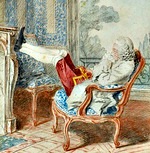
La nuit, la neige- Messages : 18132
Date d'inscription : 21/12/2013
 Re: Le vice-amiral Horatio Nelson, 1er vicomte Nelson, dit Lord Nelson
Re: Le vice-amiral Horatio Nelson, 1er vicomte Nelson, dit Lord Nelson
Mais encore.... 
- Gold and enamel Nelson memorial ring commemorating the death of Admiral Nelson at Trafalgar
Early 19th century

Photos : Sotheby's
After the death of Vice-Admiral Horatio Nelson at the battle of Trafalgar on the 21st October 1805, memorial rings were distributed by his executors, the Rt. Hon. Earl Nelson and J. Haselwood, to relatives, personal friends and the pall bearers.
Enamelled in black with a white border, each was decorated with the letters N for Nelson surmounted by a viscount’s coronet with seven pearls to commemorate Nelson’s appointment as viscount after the battle of the Nile in 1798, and B for Bronte surmounted by a ducal coronet, representing the Sicilian dukedom of Bronte conferred by Ferdinand IV of the Two Sicilies in 1799, with Trafalgar beneath.
The hoops were engraved to the outside with ‘PALMAN QUI MERUIT FERAT’ (Let him bear the palm of victory who has won it) which was granted to Nelson in 1778 and taken from the poem ‘Ad ventos’ written by John Jotin in 1727.

Photos : Sotheby's
Approximately fifty-eight of these memorial rings were distributed by the executors of Nelson’s will, thirty-one going to members of Nelson’s immediate family, while a manuscript held in the British Museum lists the original recipients of the rings.
- BUST OF LORD NELSON
After a model by Franz Thaller (1759-1817) and Matthias Ranson (fl. circa 1800)
British, first half 19th century
the socle initialled: J.B.S.
white marble, on a white marble socle initialled: JBS
bust: 58.5cm; 23in.;
overall: 71cm; 28 in.

Photos : Sotheby's
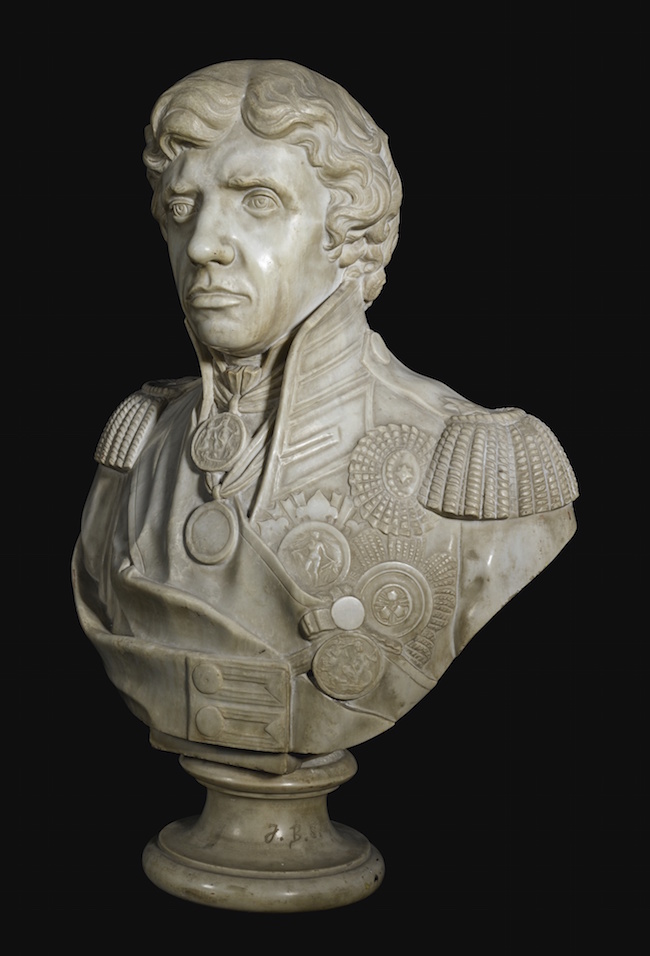
Photos : Sotheby's
In the present portrait, Nelson is depicted in rear-admiral's full dress uniform and wearing various decorations, including the two large naval medals he was awarded for the battles of Cape St Vincent and the Nile: a third was award posthumously for Trafalgar, the other decorations are the order of the Crescent, given to Nelson by Sultan Selim III, the Neapolitan order of St Ferdinand (to the left of the Crescent), and below these the Most Honourable Order of the Bath, awarded in 1797.
- Eight engraved glass rummers, circa 1805
Each ovoid bowl engraved with the initial 'N', the lower half cut with flutes, above a plain stem and stepped conical foot,
Quantity: 8
Provenance : Vice-Admiral Horatio, Viscount Nelson KB;
Catherine Matcham, his sister;
Thence by descent

Photos : Sotheby's
- A set of three engraved and faceted full-size and two half-size decanters and stoppers, circa 1805
Each of ovoid shouldered form inscribed with the initial N, in two styles, cut with flutes and facets with two neck rings and an everted rim, the ball stopper faceted overall, 27cm; 10 5/8 in. and 23.5cm; 9 1/4 in. high, together with a cylindrical decanter and stopper with applied partially legible paper label, 21.5cm., 8 1/2 in. high, and additional cut glass stopper
Quantity: 13
Provenance : Vice-Admiral Horatio, Viscount Nelson KB;
Catherine Matcham, his sister;
Thence by descent
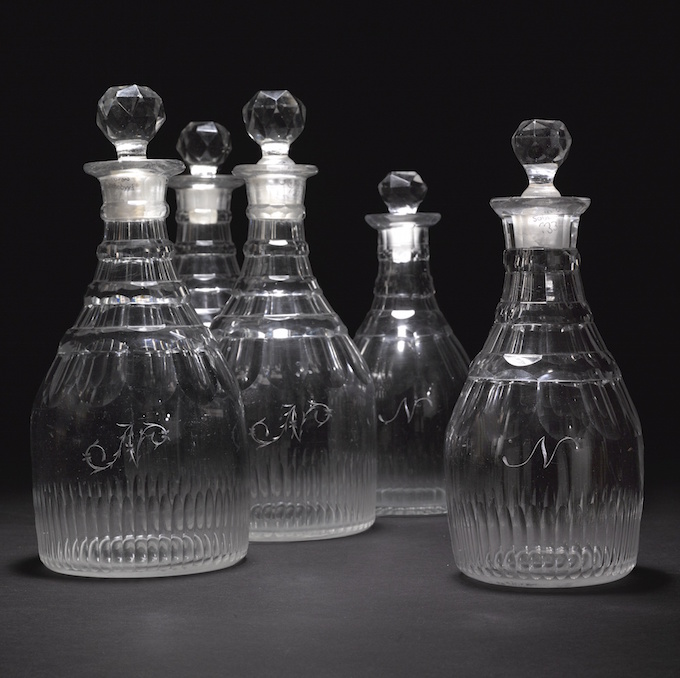
Photos : Sotheby's
Lord Nelson's Grog Chest,
A travelling chest with decanter set, wine glasses and beaker for Lord Nelson, circa 1800
the velvet-lined fitted rectangular casket with hinged lid and brass mounts to the edges, two swing handles to the sides, a small rectangular drawer below with key plate, the escutcheon on the lid inscribed 'Admiral Lord Nelson's/ Chest.', the lockplate inscribed 'John Frederick/ Foster,/ The Gift of his Aunt/M.H. Todd, /May 1875.'
Five contemporary rectangular shouldered canister flasks, with narrow necks and everted rim, each engraved GIII within branches of lily of the valley; a later flask, inscribed Vic, with similar floral engraving; a flared beaker, inscribed GIII; two earlier drawn-trumpet wine glasses, inscribed Vic within tied branches of lily of the valley;
Quantity: 10
Provenance : On their receipt is written that 'This chest formerly belonged to Admiral Nelson, was inherited by the godson Horatio Nelson Atkinson, the son of the Master of the Victory at the Battle of Trafalgar.
It came into the possession of M.H. Todd of Keswick, Cumberland and passed by descent from her nephew John Frederick Foster to Elizabeth Foster, Duchess of Devonshire.
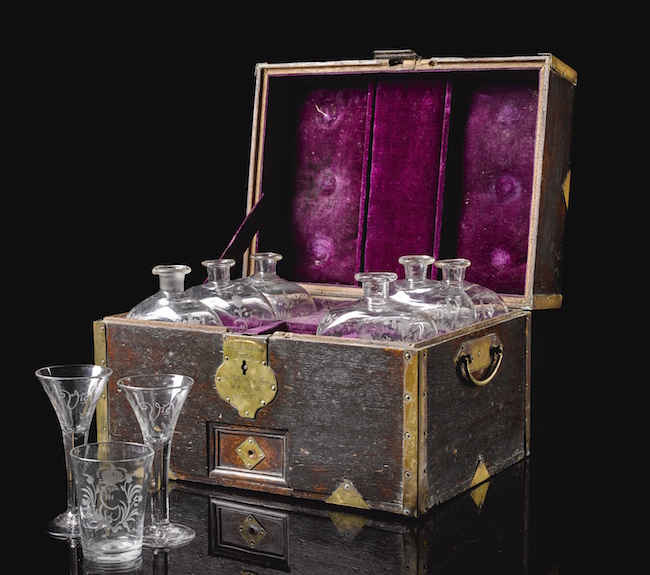
Photos : Sotheby's
- A model of HMS Victory [1765],
20th century

Photo : Sotheby's
- 'The Matcham Service'
An English porcelain dessert service, attributed to the Coalport factory but painted outside the factory, circa 1802
Painted at the centres with a fouled anchor and palm branches beneath a coronet and the gilded initials HN, the border painted with oak leaves reserving sepia panels depicting views of the Nile and Copenhagen (...)

Note au catalogue (extraits) :
The Merton Inventory compiled after the death of Lord Nelson lists all of Emma Hamilton's possessions at her 'Paradise' Merton Place. The inventory listed five named services including the 'Nelson service', a dessert service, London-decorated on Coalport and Paris porcelain, painted at the centres with the full coat-of-arms of Horatio, Viscount Nelson; and the’ Baltic Service’, a tea and coffee service London-decorated on Paris porcelain, inscribed ‘Nelson/ 2nd April/ Baltic'. Both services like the present service are decorated with an oak-leaf border.
It has been suggested that the present dessert service may have been a gift from Nelson to his sister Catherine ‘Kitty’ Matcham (1767-1842).
- Lord Nelson's Silver - A pair of George III silver sauce tureens presented to Lord Nelson by Lloyd's Coffee House following the Battle of Copenhagen, Daniel Pontifex, London, 1799
From a set of eight in the Copenhagen service; boat shaped, on oblong plinths, with gadrooned borders, harp shaped handles, the full Copenhagen inscription is engraved on one side with Nelson's coat-of-arms as a Viscount on the other, the cover has the chelengk crest one side with naval crown and Viscount's coronet, together with a pair of George III Old English pattern silver sauce ladles, George Smith, London, 1799; and another, Eley & Fearn, London, 1801, crested
Provenance : Vice-Admiral Horatio, Viscount Nelson K.G.;
Catherine Matcham, his sister;
Thence by descent

Photo : Sotheby's

Photo : Sotheby's
- A George III old English pattern silver straining spoon, Solomon Hougham, London, 1802
Engraved with Nelson crests; the first with star representing the Order of the Bath and naval crown surmounted by a duke's coronet, the second with motto 'Faith and Works' and ship's stern inscribed 'San Josef' surmounted by a baron's cap.
Provenance : Vice-Admiral Horatio, Viscount Nelson K.G.;
Catherine Matcham, his sister;
Thence by descent

Photo : Sotheby's

Photo : Sotheby's
- A pair of Lord Nelson's Sheffield plate entreé dishes and covers, with heater stand bases, English, circa 1800
Oval with gadroon borders, turned wood covered handles, the covers engraved with ship's stern and the motto 'Faith and Works' below baron's Cap
Provenance : Vice-Admiral Horatio, Viscount Nelson K.G.;
Catherine Matcham, his sister;
Thence by descent

Photo : Sotheby's
 Sources et infos complémentaires : http://www.sothebys.com/pdf/2017/L18306B/index.html
Sources et infos complémentaires : http://www.sothebys.com/pdf/2017/L18306B/index.html
- Gold and enamel Nelson memorial ring commemorating the death of Admiral Nelson at Trafalgar
Early 19th century

Photos : Sotheby's
After the death of Vice-Admiral Horatio Nelson at the battle of Trafalgar on the 21st October 1805, memorial rings were distributed by his executors, the Rt. Hon. Earl Nelson and J. Haselwood, to relatives, personal friends and the pall bearers.
Enamelled in black with a white border, each was decorated with the letters N for Nelson surmounted by a viscount’s coronet with seven pearls to commemorate Nelson’s appointment as viscount after the battle of the Nile in 1798, and B for Bronte surmounted by a ducal coronet, representing the Sicilian dukedom of Bronte conferred by Ferdinand IV of the Two Sicilies in 1799, with Trafalgar beneath.
The hoops were engraved to the outside with ‘PALMAN QUI MERUIT FERAT’ (Let him bear the palm of victory who has won it) which was granted to Nelson in 1778 and taken from the poem ‘Ad ventos’ written by John Jotin in 1727.

Photos : Sotheby's
Approximately fifty-eight of these memorial rings were distributed by the executors of Nelson’s will, thirty-one going to members of Nelson’s immediate family, while a manuscript held in the British Museum lists the original recipients of the rings.
- BUST OF LORD NELSON
After a model by Franz Thaller (1759-1817) and Matthias Ranson (fl. circa 1800)
British, first half 19th century
the socle initialled: J.B.S.
white marble, on a white marble socle initialled: JBS
bust: 58.5cm; 23in.;
overall: 71cm; 28 in.

Photos : Sotheby's

Photos : Sotheby's
In the present portrait, Nelson is depicted in rear-admiral's full dress uniform and wearing various decorations, including the two large naval medals he was awarded for the battles of Cape St Vincent and the Nile: a third was award posthumously for Trafalgar, the other decorations are the order of the Crescent, given to Nelson by Sultan Selim III, the Neapolitan order of St Ferdinand (to the left of the Crescent), and below these the Most Honourable Order of the Bath, awarded in 1797.
- Eight engraved glass rummers, circa 1805
Each ovoid bowl engraved with the initial 'N', the lower half cut with flutes, above a plain stem and stepped conical foot,
Quantity: 8
Provenance : Vice-Admiral Horatio, Viscount Nelson KB;
Catherine Matcham, his sister;
Thence by descent

Photos : Sotheby's
- A set of three engraved and faceted full-size and two half-size decanters and stoppers, circa 1805
Each of ovoid shouldered form inscribed with the initial N, in two styles, cut with flutes and facets with two neck rings and an everted rim, the ball stopper faceted overall, 27cm; 10 5/8 in. and 23.5cm; 9 1/4 in. high, together with a cylindrical decanter and stopper with applied partially legible paper label, 21.5cm., 8 1/2 in. high, and additional cut glass stopper
Quantity: 13
Provenance : Vice-Admiral Horatio, Viscount Nelson KB;
Catherine Matcham, his sister;
Thence by descent

Photos : Sotheby's
Lord Nelson's Grog Chest,
A travelling chest with decanter set, wine glasses and beaker for Lord Nelson, circa 1800
the velvet-lined fitted rectangular casket with hinged lid and brass mounts to the edges, two swing handles to the sides, a small rectangular drawer below with key plate, the escutcheon on the lid inscribed 'Admiral Lord Nelson's/ Chest.', the lockplate inscribed 'John Frederick/ Foster,/ The Gift of his Aunt/M.H. Todd, /May 1875.'
Five contemporary rectangular shouldered canister flasks, with narrow necks and everted rim, each engraved GIII within branches of lily of the valley; a later flask, inscribed Vic, with similar floral engraving; a flared beaker, inscribed GIII; two earlier drawn-trumpet wine glasses, inscribed Vic within tied branches of lily of the valley;
Quantity: 10
Provenance : On their receipt is written that 'This chest formerly belonged to Admiral Nelson, was inherited by the godson Horatio Nelson Atkinson, the son of the Master of the Victory at the Battle of Trafalgar.
It came into the possession of M.H. Todd of Keswick, Cumberland and passed by descent from her nephew John Frederick Foster to Elizabeth Foster, Duchess of Devonshire.

Photos : Sotheby's
- A model of HMS Victory [1765],
20th century

Photo : Sotheby's
- 'The Matcham Service'
An English porcelain dessert service, attributed to the Coalport factory but painted outside the factory, circa 1802
Painted at the centres with a fouled anchor and palm branches beneath a coronet and the gilded initials HN, the border painted with oak leaves reserving sepia panels depicting views of the Nile and Copenhagen (...)

Note au catalogue (extraits) :
The Merton Inventory compiled after the death of Lord Nelson lists all of Emma Hamilton's possessions at her 'Paradise' Merton Place. The inventory listed five named services including the 'Nelson service', a dessert service, London-decorated on Coalport and Paris porcelain, painted at the centres with the full coat-of-arms of Horatio, Viscount Nelson; and the’ Baltic Service’, a tea and coffee service London-decorated on Paris porcelain, inscribed ‘Nelson/ 2nd April/ Baltic'. Both services like the present service are decorated with an oak-leaf border.
It has been suggested that the present dessert service may have been a gift from Nelson to his sister Catherine ‘Kitty’ Matcham (1767-1842).
- Lord Nelson's Silver - A pair of George III silver sauce tureens presented to Lord Nelson by Lloyd's Coffee House following the Battle of Copenhagen, Daniel Pontifex, London, 1799
From a set of eight in the Copenhagen service; boat shaped, on oblong plinths, with gadrooned borders, harp shaped handles, the full Copenhagen inscription is engraved on one side with Nelson's coat-of-arms as a Viscount on the other, the cover has the chelengk crest one side with naval crown and Viscount's coronet, together with a pair of George III Old English pattern silver sauce ladles, George Smith, London, 1799; and another, Eley & Fearn, London, 1801, crested
Provenance : Vice-Admiral Horatio, Viscount Nelson K.G.;
Catherine Matcham, his sister;
Thence by descent

Photo : Sotheby's

Photo : Sotheby's
- A George III old English pattern silver straining spoon, Solomon Hougham, London, 1802
Engraved with Nelson crests; the first with star representing the Order of the Bath and naval crown surmounted by a duke's coronet, the second with motto 'Faith and Works' and ship's stern inscribed 'San Josef' surmounted by a baron's cap.
Provenance : Vice-Admiral Horatio, Viscount Nelson K.G.;
Catherine Matcham, his sister;
Thence by descent

Photo : Sotheby's

Photo : Sotheby's
- A pair of Lord Nelson's Sheffield plate entreé dishes and covers, with heater stand bases, English, circa 1800
Oval with gadroon borders, turned wood covered handles, the covers engraved with ship's stern and the motto 'Faith and Works' below baron's Cap
Provenance : Vice-Admiral Horatio, Viscount Nelson K.G.;
Catherine Matcham, his sister;
Thence by descent

Photo : Sotheby's

La nuit, la neige- Messages : 18132
Date d'inscription : 21/12/2013
 Re: Le vice-amiral Horatio Nelson, 1er vicomte Nelson, dit Lord Nelson
Re: Le vice-amiral Horatio Nelson, 1er vicomte Nelson, dit Lord Nelson
Et encore...
- THE OPENING ENGAGEMENT AT TRAFALGAR; H.M.S. 'ROYAL SOVEREIGN' RAKING THE STERN OF THE SPANISH FLAGSHIP 'SANTA ANA'
By John Wilson Carmichael (1799-1868)

Photo : Sotheby's
Note au catalogue (extraits)
Britain’s famous victory over the combined Spanish and French fleets at the Battle of Trafalgar in 1805 was the Royal Navy’s greatest victory - affirming Britain’s maritime supremacy and dashing Napoleon’s ambitions for an invasion.
Lacking a numerical advantage but confident in the superior seamanship and gunnery of his crews, Lord Nelson devised a bold and unorthodox military tactic to split the enemy line by attacking it in two columns.
It proved a masterful stroke, and his death in the course of his greatest triumph immortalised his memory in the nation’s history.
In the present painting, Carmichael depicts the decisive moment when Rear Admiral Lord Collingwood, in command of ‘Royal Sovereign’, broke through the Spanish line and rounded on ‘Santa Ana’ – the huge 112-gun Spanish flagship of Vice-Admiral de Alava.

All fifty of 'Royal Sovereign’s' port broadside, double shotted, poured into ‘Santa Ana’s’ unprotected stern at a range of thirty yards. Then, putting his helm hard over, Collingwood ranged up the lee side of the Spaniard for the coup de grace.
It proved the brilliance of Nelson’s strategy, and Collingwood’s manoeuvre was completed even before ‘Victory’ herself entered the fray at the head of the other column.
Et enfin, last but not least...
- LARGE FRAGMENT OF THE UNION FLAG, BELIEVED TO HAVE FLOWN FROM HMS VICTORY AT THE BATTLE OF TRAFALGAR
Battle of Trafalgar--HMS Victory, 'The Victory Jack'
Comprising eight panels of red, white and blue hand-woven woollen bunting, hand-stitched together to form part of the bottom-right (or top-left) quadrant of the Union flag, hemmed at the bottom (or top), hem turned over enclosing c.460mm of twine, crudely torn at the edges, c.860 x 920 mm, mounted, framed, and glazed (frame size 1125 x 1125mm), c.1801-1805
Provenance : "Captain W.H. Dobbie, RN", presumably William Hugh Dobbie, 1771-1830, who served in the East Indies Station from 1790 to 1808; gifted by him to the Museum of the Royal United Services Institute (...)

Photos : Sotheby's
Note au catalogue (extraits) :
Nelson's ships sailed into battle at Trafalgar flying the national flag rather than just their squadron colours, as a result of an order issued by Nelson in the days before the battle:
"When in the presence of an Enemy, all the Ships under my command are to bear white Colours [i.e. St George's Ensign], and a Union Jack is to be suspended from the fore top-gallant stay" (10 October 1805).
HMS Victory consequently flew two Union flags and a St George's Ensign, which were returned to England with the ship and the body of Nelson.
These battle ensigns, unique patriotic mementoes of Nelson's final and greatest victory, were later woven into the solemn and dignified series of ceremonials that marked his state funeral in January 1806.
The body lay in state at the Painted Hall at Greenwich for four days before processing upriver in a funeral barge with a flotilla of naval escorts, disembarking at Whitehall Stairs and resting overnight in the Admiralty.
The following day, 9 January, a vast procession followed Nelson's remains to St Paul's Cathedral, the site of the funeral. Incorporated into the funeral cortege was a group of 48 seamen and Marines from HMS Victory, who bore with them the ship's three battle ensigns and were, according to one eyewitness, "repeatedly and almost continually cheered as they passed along".
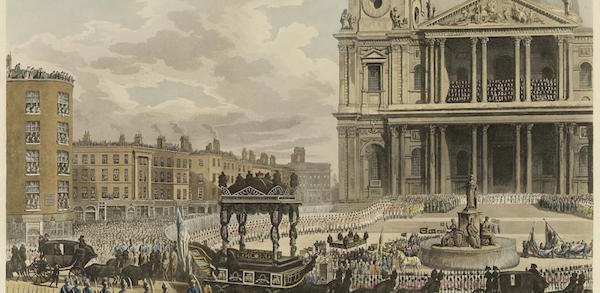
At the conclusion of the funeral service, with the coffin placed at the heart of the cathedral beneath Wren's great dome, the sailors were supposed to fold the flags and place them reverently on the coffin.

Most of the surviving fragments of the Victory's flags are much smaller than the current piece.
Small fragments of white and blue bunting, no more than 12cm in length, have appeared at auction and other similar fragments are found at the National Maritime Museum and other institutional collections.
Only two complete Union jacks that were used as battle ensigns at Trafalgar survive: one from HMS Minotaur (National Maritime Museum), the other from HMS Spartiate.

Photo : Sotheby's
 Sources et infos complémentaires : http://www.sothebys.com/pdf/2017/L18306B/index.html
Sources et infos complémentaires : http://www.sothebys.com/pdf/2017/L18306B/index.html
- THE OPENING ENGAGEMENT AT TRAFALGAR; H.M.S. 'ROYAL SOVEREIGN' RAKING THE STERN OF THE SPANISH FLAGSHIP 'SANTA ANA'
By John Wilson Carmichael (1799-1868)

Photo : Sotheby's
Note au catalogue (extraits)
Britain’s famous victory over the combined Spanish and French fleets at the Battle of Trafalgar in 1805 was the Royal Navy’s greatest victory - affirming Britain’s maritime supremacy and dashing Napoleon’s ambitions for an invasion.
Lacking a numerical advantage but confident in the superior seamanship and gunnery of his crews, Lord Nelson devised a bold and unorthodox military tactic to split the enemy line by attacking it in two columns.
It proved a masterful stroke, and his death in the course of his greatest triumph immortalised his memory in the nation’s history.
In the present painting, Carmichael depicts the decisive moment when Rear Admiral Lord Collingwood, in command of ‘Royal Sovereign’, broke through the Spanish line and rounded on ‘Santa Ana’ – the huge 112-gun Spanish flagship of Vice-Admiral de Alava.

All fifty of 'Royal Sovereign’s' port broadside, double shotted, poured into ‘Santa Ana’s’ unprotected stern at a range of thirty yards. Then, putting his helm hard over, Collingwood ranged up the lee side of the Spaniard for the coup de grace.
It proved the brilliance of Nelson’s strategy, and Collingwood’s manoeuvre was completed even before ‘Victory’ herself entered the fray at the head of the other column.
Et enfin, last but not least...
- LARGE FRAGMENT OF THE UNION FLAG, BELIEVED TO HAVE FLOWN FROM HMS VICTORY AT THE BATTLE OF TRAFALGAR
Battle of Trafalgar--HMS Victory, 'The Victory Jack'
Comprising eight panels of red, white and blue hand-woven woollen bunting, hand-stitched together to form part of the bottom-right (or top-left) quadrant of the Union flag, hemmed at the bottom (or top), hem turned over enclosing c.460mm of twine, crudely torn at the edges, c.860 x 920 mm, mounted, framed, and glazed (frame size 1125 x 1125mm), c.1801-1805
Provenance : "Captain W.H. Dobbie, RN", presumably William Hugh Dobbie, 1771-1830, who served in the East Indies Station from 1790 to 1808; gifted by him to the Museum of the Royal United Services Institute (...)

Photos : Sotheby's
Note au catalogue (extraits) :
Nelson's ships sailed into battle at Trafalgar flying the national flag rather than just their squadron colours, as a result of an order issued by Nelson in the days before the battle:
"When in the presence of an Enemy, all the Ships under my command are to bear white Colours [i.e. St George's Ensign], and a Union Jack is to be suspended from the fore top-gallant stay" (10 October 1805).
HMS Victory consequently flew two Union flags and a St George's Ensign, which were returned to England with the ship and the body of Nelson.
These battle ensigns, unique patriotic mementoes of Nelson's final and greatest victory, were later woven into the solemn and dignified series of ceremonials that marked his state funeral in January 1806.
The body lay in state at the Painted Hall at Greenwich for four days before processing upriver in a funeral barge with a flotilla of naval escorts, disembarking at Whitehall Stairs and resting overnight in the Admiralty.
The following day, 9 January, a vast procession followed Nelson's remains to St Paul's Cathedral, the site of the funeral. Incorporated into the funeral cortege was a group of 48 seamen and Marines from HMS Victory, who bore with them the ship's three battle ensigns and were, according to one eyewitness, "repeatedly and almost continually cheered as they passed along".

At the conclusion of the funeral service, with the coffin placed at the heart of the cathedral beneath Wren's great dome, the sailors were supposed to fold the flags and place them reverently on the coffin.

Most of the surviving fragments of the Victory's flags are much smaller than the current piece.
Small fragments of white and blue bunting, no more than 12cm in length, have appeared at auction and other similar fragments are found at the National Maritime Museum and other institutional collections.
Only two complete Union jacks that were used as battle ensigns at Trafalgar survive: one from HMS Minotaur (National Maritime Museum), the other from HMS Spartiate.

Photo : Sotheby's

La nuit, la neige- Messages : 18132
Date d'inscription : 21/12/2013
 Re: Le vice-amiral Horatio Nelson, 1er vicomte Nelson, dit Lord Nelson
Re: Le vice-amiral Horatio Nelson, 1er vicomte Nelson, dit Lord Nelson
_________________
... demain est un autre jour .

Mme de Sabran- Messages : 55497
Date d'inscription : 21/12/2013
Localisation : l'Ouest sauvage
 Re: Le vice-amiral Horatio Nelson, 1er vicomte Nelson, dit Lord Nelson
Re: Le vice-amiral Horatio Nelson, 1er vicomte Nelson, dit Lord Nelson
Merci LNLN !!!! 


J'ai presque envie d'acheter le catalogue !



J'ai presque envie d'acheter le catalogue !

Gouverneur Morris- Messages : 11795
Date d'inscription : 21/12/2013
 Re: Le vice-amiral Horatio Nelson, 1er vicomte Nelson, dit Lord Nelson
Re: Le vice-amiral Horatio Nelson, 1er vicomte Nelson, dit Lord Nelson
Chère Clio, si tu me lis... 

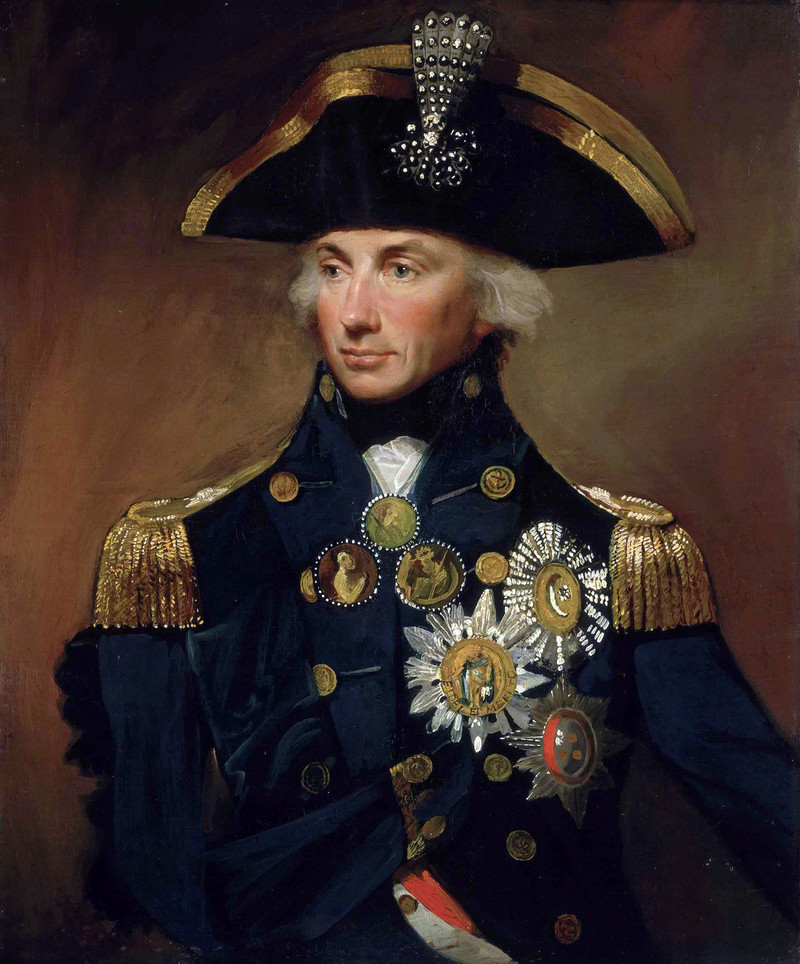
Rear-Admiral Sir Horatio Nelson, 1758-1805
By Francis Lemuel Abbott
Oil on canvas
Photo : National Maritime Museum, Greenwich, London. Caird Fund
 Dernièrement, Franck Ferrand consacrait l'un des épisodes de son émission de radio, Franck Ferrand raconte (Radio Classique) au célèbre Horatio Nelson, et en particulier à la bataille qui consacrera sa légende et où il trouvera la mort : Trafalgar ou le Waterloo sur mer.
Dernièrement, Franck Ferrand consacrait l'un des épisodes de son émission de radio, Franck Ferrand raconte (Radio Classique) au célèbre Horatio Nelson, et en particulier à la bataille qui consacrera sa légende et où il trouvera la mort : Trafalgar ou le Waterloo sur mer.

The Fall of Nelson, Battle of Trafalgar, 21 October 1805
By Denis Dighton, c. 1825
Oil on canvas
Photo : National Maritime Museum, Greenwich, London. Caird Fund
 L'émission, en écoute libre (environ 30 mn), c'est ici : Franck Ferrand raconte : Nelson à Trafalgar (émission du 29.11.18)
L'émission, en écoute libre (environ 30 mn), c'est ici : Franck Ferrand raconte : Nelson à Trafalgar (émission du 29.11.18)



Rear-Admiral Sir Horatio Nelson, 1758-1805
By Francis Lemuel Abbott
Oil on canvas
Photo : National Maritime Museum, Greenwich, London. Caird Fund

The Fall of Nelson, Battle of Trafalgar, 21 October 1805
By Denis Dighton, c. 1825
Oil on canvas
Photo : National Maritime Museum, Greenwich, London. Caird Fund

La nuit, la neige- Messages : 18132
Date d'inscription : 21/12/2013
 Re: Le vice-amiral Horatio Nelson, 1er vicomte Nelson, dit Lord Nelson
Re: Le vice-amiral Horatio Nelson, 1er vicomte Nelson, dit Lord Nelson
La nuit, la neige a écrit:Chère Clio, si tu me lis...

Talleyrand, Nelson ... Ma parole, Clio n'aime que les estropiés; il les lui faut tous !

Momo, tu as toutes tes chances !!!

_________________
... demain est un autre jour .

Mme de Sabran- Messages : 55497
Date d'inscription : 21/12/2013
Localisation : l'Ouest sauvage
 Re: Le vice-amiral Horatio Nelson, 1er vicomte Nelson, dit Lord Nelson
Re: Le vice-amiral Horatio Nelson, 1er vicomte Nelson, dit Lord Nelson
Mme de Sabran a écrit:
Momo, tu as toutes tes chances !!!






Gouverneur Morris- Messages : 11795
Date d'inscription : 21/12/2013
 Re: Le vice-amiral Horatio Nelson, 1er vicomte Nelson, dit Lord Nelson
Re: Le vice-amiral Horatio Nelson, 1er vicomte Nelson, dit Lord Nelson
Mme de Sabran a écrit:La nuit, la neige a écrit:Chère Clio, si tu me lis...

Talleyrand, Nelson ... Ma parole, Clio n'aime que les estropiés; il les lui faut tous !
Momo, tu as toutes tes chances !!!

 Re: Le vice-amiral Horatio Nelson, 1er vicomte Nelson, dit Lord Nelson
Re: Le vice-amiral Horatio Nelson, 1er vicomte Nelson, dit Lord Nelson
Notre chère Clio aime les hommes qui sortent du commun des mortels. 


La nuit, la neige- Messages : 18132
Date d'inscription : 21/12/2013
 Re: Le vice-amiral Horatio Nelson, 1er vicomte Nelson, dit Lord Nelson
Re: Le vice-amiral Horatio Nelson, 1er vicomte Nelson, dit Lord Nelson
... nous toutes .
_________________
... demain est un autre jour .

Mme de Sabran- Messages : 55497
Date d'inscription : 21/12/2013
Localisation : l'Ouest sauvage
 Re: Le vice-amiral Horatio Nelson, 1er vicomte Nelson, dit Lord Nelson
Re: Le vice-amiral Horatio Nelson, 1er vicomte Nelson, dit Lord Nelson
Présentés à l'occasion de la vente aux enchères Napoléon Bonaparte, The British Sale, organisée par la maison Bonhams, le 27 octobre prochain, à Londres :
Sir Horatio Nelson
Palermo School
charcoal and sanguine, circa 1799
17.8 x 12.7cm
Profile portrait of Rear-Admiral Sir Horatio Nelson (1758-1805), in profile facing left, wearing the Chelengk presented by Emperor Selim III in his bicorn, displaying his Naval gold medals, the Ottoman Order of the Crescent and the Order of the Bath
Provenance: Sir Thomas Masterman Hardy (1769-1839), to whom reputedly given by Nelson ; his nephew, William Mansfield (1832-1892), Portesham House, Dorset ; his son, William Hardy Manfield (1859-1937) who married Julia Mary Manfield (née Butlin, 1881-1974), who was the great aunt of the current owners.

Lot Essay
According to family tradition the present drawing (along with that of King Ferdinand IV of Naples, in this sale, lot 42, and a group of miniatures of about the same date) were given by Rear-Admiral Sir Horatio Nelson to Captain Sir Thomas Masterman Hardy, his close comrade, in whose arms he famously died at the Battle of Trafalgar.
This was supposedly done with instructions for framing the drawing and orders for copies to be made for his friends.
It appears that one of these copies belonged to Captain Savage of the Marines (afterwards Major-General Sir J Boscawen Savage) who lent it to Thomas Burke for a stipple engraving to be made, which was lettered: 'Engraved by Burke from an original drawing taken at Palermo/in possession of Capt.n J.G. Savage of Marines/Baron Nelson of the Nile/Published by John Brydon No 7 Charing Cross, London 1st August 1800'. The present work that belonged to Hardy is briefly mentioned in a letter to his legal adviser and brother-in-law, dated 7 January, 1801 aboard the San Josef at Hamoaze:
'Dear Manfield ... I am happy the prints please. A Register Stove & Carpet with the Hero of the Nile's Picture (which Jno. Brown will of course get) cannot fail to make it the Handsomest Drawing Room in Dorchester. The King of Naples's Picture will follow from Mr M'Arthur...'
Both the drawing of Nelson and that of King Ferdinand of Naples (lot 42) which was by family tradition discovered hidden behind the portrait of Nelson) were in the Hardy Manfield collection at Portesham House and now belong to a collateral descendant.
(...)
The drawing of Nelson is widely purported to have been drawn during Nelson's stay in Palermo between January 1799 and June 1800. In a dramatic escape during tempestuous weather on the 23rd December, 1798, and with the grim fate of the Queen's sister, Marie Antoinette, in vivid memory, King Ferdinand and Queen Maria Carolina left their home in Naples ahead of the impending French invasion, escorted by Nelson and accompanied by Thomas Hardy (along with Sir William and Emma Lady Hamilton and the King's favourite dogs).
The British ship the Vanguard (of which Hardy was captain) reached Palermo with its large convoy on the 26th. The royal couple had been heavily criticised for abandoning their capital and seeking refuge in Palermo, instead of risking humiliation and expulsion, or even violent death. By going to Palermo, however, they remained on their own sovereign territory, which they were able to use as a base for recovering the rest of the realm: indeed, Nelson had advised this course, and he was no coward. The royal couple have also been castigated for removing as many valuables as possible, but the simple alternative was to leave them for the French, who had already appropriated a number of Italy's most significant treasures.
In the end the Neapolitan (or Pathenopean) Republic proved temporary and the rebels capitulated to Cardinal Fabrizio Ruffo's counter-revolutionary 'Christian army of the Holy Faith', with the support of Russian and Turkish ships. In his The Bourbons of Naples, Harold Acton wrote of how in August 1799, following this victory 'The King had sailed into Palermo with Nelson on the Foudroyant and received acclamations worthy of a hero. The Queen and her children dined on board in the glitter and noise of a flaming noon, and the whole party landed to the salutes of twenty-one guns on a special stage of gilded stucco where the senators in rich robes awaited them; then they drove in state to the cathedral for the solemn Te Deum amid thousands of cheering citizens. Palermo was drunk but not disorderly, as the Queen wrote to Ruffo. The fireworks, illuminations and festivities that followed merged into the celebrations of the city's patron saint Rosalia, which were never more magnificent.'
The Queen rewarded the Hamiltons with jewels and other lavish gifts reputed to be worth £6,000; while the King bestowed on Nelson a sword with a jewelled hilt worth 3,000 guineas and the Sicilian duchy and domain of Bronte, on the outskirts of Mount Etna, whose annual revenue was calculated at £3,000. At this time Emma Hamilton had acted as a go-between, conveying messages from the Queen to Nelson and from Nelson to the Queen and it was during this period that Nelson became besotted with Emma.

It was also in August 1799 that the Ottoman Sultan Selim III specially created the Order of the Crescent for Nelson, making him its first Knight and sending him the insignia that month. He is seen wearing the order in the present portrait and it was mostly likely in this celebratory context that this drawing was commissioned.
The distinctive Chelengk seen here prominently displayed on Nelson's bicorn, was a plume of more than 300 diamonds with a unique rotating central feature surrounded by exquisite enamelled flowers. Like the Order of the Crescent it was presented to Nelson by Sultan Selim III in recognition of his daring 1798 defeat of the French fleet in the Battle of the Nile, when Egypt was still under the control of the Ottoman Empire.
At the time, a Chelengk was a type of military medal highly prized across the Ottoman world. As the first such decoration ever presented by the Sultan to a non-Muslim, Nelson's Chelengk was the subject of great pride to him: crowned by 13 diamond sprigs representing the number of ships sunk by Nelson during the historic battle, it was one of his most cherished possessions which he wore like a traditional turban ornament and which was later included in his coat-of-arms.
Nelson is also shown wearing his prized flag officer's gold medal for the victory at the Nile in this portrait.
King Ferdinand IV of Naples and III of Sicily
Palermo school
charcoal and coloured chalk on laid paper, circa 1799
18 x 12cm
Portrait of King Ferdinand IV of Naples and III of Sicily (1751-1825), in profile facing left, wearing a blue coat with red collar and wearing the breast-stars of the Royal Sicilian Orders of Saint Januarius, Saint Ferdinand and of Merit
Provenance:
Sir Thomas Masterman Hardy (1769-1839), to whom reputedly given by Nelson ; his nephew, William Mansfield (circa 1848-1892), Portesham House, Dorset, and thence by family descent to the current owners.

According to family tradition, the present drawing was discovered hidden behind the portrait of Nelson, lot 40 in this sale and which was given by Rear-Admiral Sir Horatio Nelson to Captain Sir Thomas Masterman Hardy (see lot ??? for a description of the events surrounding the background of these two drawings).
* Source et infos complémentaires : Bonhams London - Napoléon Bonaparte, The British Sale (27 October 2021)
Sir Horatio Nelson
Palermo School
charcoal and sanguine, circa 1799
17.8 x 12.7cm
Profile portrait of Rear-Admiral Sir Horatio Nelson (1758-1805), in profile facing left, wearing the Chelengk presented by Emperor Selim III in his bicorn, displaying his Naval gold medals, the Ottoman Order of the Crescent and the Order of the Bath
Provenance: Sir Thomas Masterman Hardy (1769-1839), to whom reputedly given by Nelson ; his nephew, William Mansfield (1832-1892), Portesham House, Dorset ; his son, William Hardy Manfield (1859-1937) who married Julia Mary Manfield (née Butlin, 1881-1974), who was the great aunt of the current owners.

Lot Essay
According to family tradition the present drawing (along with that of King Ferdinand IV of Naples, in this sale, lot 42, and a group of miniatures of about the same date) were given by Rear-Admiral Sir Horatio Nelson to Captain Sir Thomas Masterman Hardy, his close comrade, in whose arms he famously died at the Battle of Trafalgar.
This was supposedly done with instructions for framing the drawing and orders for copies to be made for his friends.
It appears that one of these copies belonged to Captain Savage of the Marines (afterwards Major-General Sir J Boscawen Savage) who lent it to Thomas Burke for a stipple engraving to be made, which was lettered: 'Engraved by Burke from an original drawing taken at Palermo/in possession of Capt.n J.G. Savage of Marines/Baron Nelson of the Nile/Published by John Brydon No 7 Charing Cross, London 1st August 1800'. The present work that belonged to Hardy is briefly mentioned in a letter to his legal adviser and brother-in-law, dated 7 January, 1801 aboard the San Josef at Hamoaze:
'Dear Manfield ... I am happy the prints please. A Register Stove & Carpet with the Hero of the Nile's Picture (which Jno. Brown will of course get) cannot fail to make it the Handsomest Drawing Room in Dorchester. The King of Naples's Picture will follow from Mr M'Arthur...'
Both the drawing of Nelson and that of King Ferdinand of Naples (lot 42) which was by family tradition discovered hidden behind the portrait of Nelson) were in the Hardy Manfield collection at Portesham House and now belong to a collateral descendant.
(...)
The drawing of Nelson is widely purported to have been drawn during Nelson's stay in Palermo between January 1799 and June 1800. In a dramatic escape during tempestuous weather on the 23rd December, 1798, and with the grim fate of the Queen's sister, Marie Antoinette, in vivid memory, King Ferdinand and Queen Maria Carolina left their home in Naples ahead of the impending French invasion, escorted by Nelson and accompanied by Thomas Hardy (along with Sir William and Emma Lady Hamilton and the King's favourite dogs).
The British ship the Vanguard (of which Hardy was captain) reached Palermo with its large convoy on the 26th. The royal couple had been heavily criticised for abandoning their capital and seeking refuge in Palermo, instead of risking humiliation and expulsion, or even violent death. By going to Palermo, however, they remained on their own sovereign territory, which they were able to use as a base for recovering the rest of the realm: indeed, Nelson had advised this course, and he was no coward. The royal couple have also been castigated for removing as many valuables as possible, but the simple alternative was to leave them for the French, who had already appropriated a number of Italy's most significant treasures.
In the end the Neapolitan (or Pathenopean) Republic proved temporary and the rebels capitulated to Cardinal Fabrizio Ruffo's counter-revolutionary 'Christian army of the Holy Faith', with the support of Russian and Turkish ships. In his The Bourbons of Naples, Harold Acton wrote of how in August 1799, following this victory 'The King had sailed into Palermo with Nelson on the Foudroyant and received acclamations worthy of a hero. The Queen and her children dined on board in the glitter and noise of a flaming noon, and the whole party landed to the salutes of twenty-one guns on a special stage of gilded stucco where the senators in rich robes awaited them; then they drove in state to the cathedral for the solemn Te Deum amid thousands of cheering citizens. Palermo was drunk but not disorderly, as the Queen wrote to Ruffo. The fireworks, illuminations and festivities that followed merged into the celebrations of the city's patron saint Rosalia, which were never more magnificent.'
The Queen rewarded the Hamiltons with jewels and other lavish gifts reputed to be worth £6,000; while the King bestowed on Nelson a sword with a jewelled hilt worth 3,000 guineas and the Sicilian duchy and domain of Bronte, on the outskirts of Mount Etna, whose annual revenue was calculated at £3,000. At this time Emma Hamilton had acted as a go-between, conveying messages from the Queen to Nelson and from Nelson to the Queen and it was during this period that Nelson became besotted with Emma.

It was also in August 1799 that the Ottoman Sultan Selim III specially created the Order of the Crescent for Nelson, making him its first Knight and sending him the insignia that month. He is seen wearing the order in the present portrait and it was mostly likely in this celebratory context that this drawing was commissioned.
The distinctive Chelengk seen here prominently displayed on Nelson's bicorn, was a plume of more than 300 diamonds with a unique rotating central feature surrounded by exquisite enamelled flowers. Like the Order of the Crescent it was presented to Nelson by Sultan Selim III in recognition of his daring 1798 defeat of the French fleet in the Battle of the Nile, when Egypt was still under the control of the Ottoman Empire.
At the time, a Chelengk was a type of military medal highly prized across the Ottoman world. As the first such decoration ever presented by the Sultan to a non-Muslim, Nelson's Chelengk was the subject of great pride to him: crowned by 13 diamond sprigs representing the number of ships sunk by Nelson during the historic battle, it was one of his most cherished possessions which he wore like a traditional turban ornament and which was later included in his coat-of-arms.
Nelson is also shown wearing his prized flag officer's gold medal for the victory at the Nile in this portrait.
King Ferdinand IV of Naples and III of Sicily
Palermo school
charcoal and coloured chalk on laid paper, circa 1799
18 x 12cm
Portrait of King Ferdinand IV of Naples and III of Sicily (1751-1825), in profile facing left, wearing a blue coat with red collar and wearing the breast-stars of the Royal Sicilian Orders of Saint Januarius, Saint Ferdinand and of Merit
Provenance:
Sir Thomas Masterman Hardy (1769-1839), to whom reputedly given by Nelson ; his nephew, William Mansfield (circa 1848-1892), Portesham House, Dorset, and thence by family descent to the current owners.

According to family tradition, the present drawing was discovered hidden behind the portrait of Nelson, lot 40 in this sale and which was given by Rear-Admiral Sir Horatio Nelson to Captain Sir Thomas Masterman Hardy (see lot ??? for a description of the events surrounding the background of these two drawings).
* Source et infos complémentaires : Bonhams London - Napoléon Bonaparte, The British Sale (27 October 2021)

La nuit, la neige- Messages : 18132
Date d'inscription : 21/12/2013
 HMS Victory
HMS Victory
English, circa 1800
the black-painted tin conical-form with hinged door, the whole with twenty rectangular apertures originally fitted with horn, now retaining several remnants, the lower frieze now with a black silk and gilt tally woven with 'H.M.S. VICTORY', with smoke shade and suspension ring, included with the lot is a photograph portrait of Admiral Sir Roger Keyes together with a typed and framed letter stating 'HMS VICTORY
51cm. high; 20in
Provenance :
Supplied to HMS Victory during the refit of 1800-1803; Remaining on Victory until 1929 when presented to Admiral Sir Roger Keyes Bt., G.C.B., K.C.V.O., C.M.G.,D.S.O., LL.D.,
D.C.L.,M.P. (1872-1945) in recognition of his contribution to the restoration of HMS Victory completed that year; Thence by descent until sold, Woolley and Wallis, Salisbury, October 2005, lot 343; Private Collection, England.

The lantern, which pre-dates the refit HMS Victory received following the Battle of Trafalger [sic] is a momento of that single glorious victory obtained over the combined fleets of France and Spain under the overall command of Vice Admiral Lord Viscount Nelson on the 21st October 1805.'
This lantern was presented in 1929 to Admiral of the Fleet Sir Roger Keyes during a ceremony on board HMS Victory whilst still afloat in recognition of his role in overseeing her restoration which was completed that year.

* Source et infos complémentaires : Sotheby's - Auction "Treasures" (London, 5 July 2022)
English, circa 1800
40cm. high, 142cm. wide, 34cm. deep; 15 ¾ in., 56 in., 13 ½ in.
Provenance :
Probably George Green (1767-1849) of Blackwall Dockyard, London; Messrs R and H Green, shipbuilders of Blackwall Dockyard, London; Henry Green (1838-1900); Admiral Sir John Frederick Ernest Green, KCMG CB (1866-1948); Thence by direct family descent.

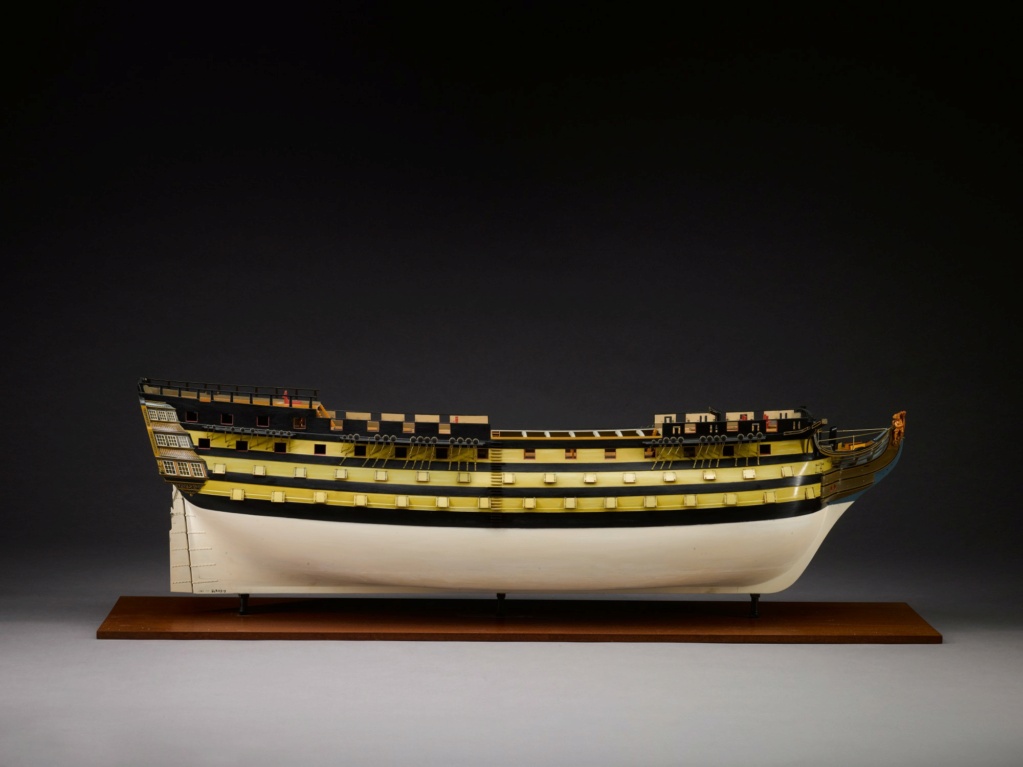
Description
Constructed during Victory’s large repair in 1800-1803 and the only known contemporary full hull model of Admiral Lord Nelson’s celebrated flagship in the state that she fought the battle of Trafalgar.


* Source et infos complémentaires : Sotheby's - Auction "Treasures" (London, 5 July 2022)
_________________
HMS VICTORY (1765)
Le HMS Victory est un navire de ligne de premier rang britannique à trois-mâts voiles carrées.
Il est principalement connu comme le vaisseau de l'amiral Nelson lors de la bataille de Trafalgar (vaisseau amiral en second de l'état-major de la Marine, commandant en chef de l'amirauté). Il connut une succession de victoires à la tête de la flotte britannique entre 1778 et 1812.
Lancé en 1765 et désormais préservé en cale sèche, il est le plus ancien navire de guerre intact au monde. La frégate américaine USS Constitution, lancée en 1797, est quant à elle le plus ancien navire de guerre encore à flot.

HMS Victory in dock at HMNB Portsmouth, 1999.
Air to ground photograph. Nelsons Flag Ship
Image : Geoff Parselle / Commons Wikimedia
Le HMS Victory est construit entre 1759 et 1765 au Chatham Dockyard, il est mis en réserve jusqu'en 1778.
En 1778, le HMS Victory devient le navire amiral d'Augustus Keppel, quand commence la guerre d'indépendance américaine en 1778 (bataille d'Ouessant de 1778).

Combat d'Ouessant, 23 juillet 1778
Théodore Gudin
Huile sur toile, 1839
Image : Paris, Musée national de la Marine / Commons Wikimedia
En 1780, il subit une modification pour améliorer la résistance de sa coque contre les organismes marin : 3923 plaques de cuivre (17 tonnes au total) viennent recouvrir la base de la coque.
En 1781, le HMS Victory est le navire amiral de Richard Kempenfelt, lors de sa victoire à Ouessant la 12 décembre 1781 (bataille d'Ouessant de 1781). En 1782, le HMS Victory est le navire amiral de Richard Howe, basé à Gibraltar.

Rear-admiral Richard Kempenfelt (1718-1782)
Oil on canvas, 1781
Image : Commons Wikimedia
En 1792, le HMS Victory est le navire amiral de Samuel Hood, commandant en chef la flotte britannique en Méditerranée. En 1793 Il occupe Toulon que lui ont livrée les royalistes et s’empare des vaisseaux français. Il doit cependant l’abandonner face au siège des troupes de Charles-François Dumouriez.
Il occupe brièvement la Corse livrée par Paoli mais échoue en raison des vents défavorables dans une tentative de reprise de Toulon début 1794. Critiqué sur la façon dont il a mené les opérations en Méditerranée, il est rappelé. Bien que promu amiral et vicomte en 1796 il n’exercera plus de commandement.
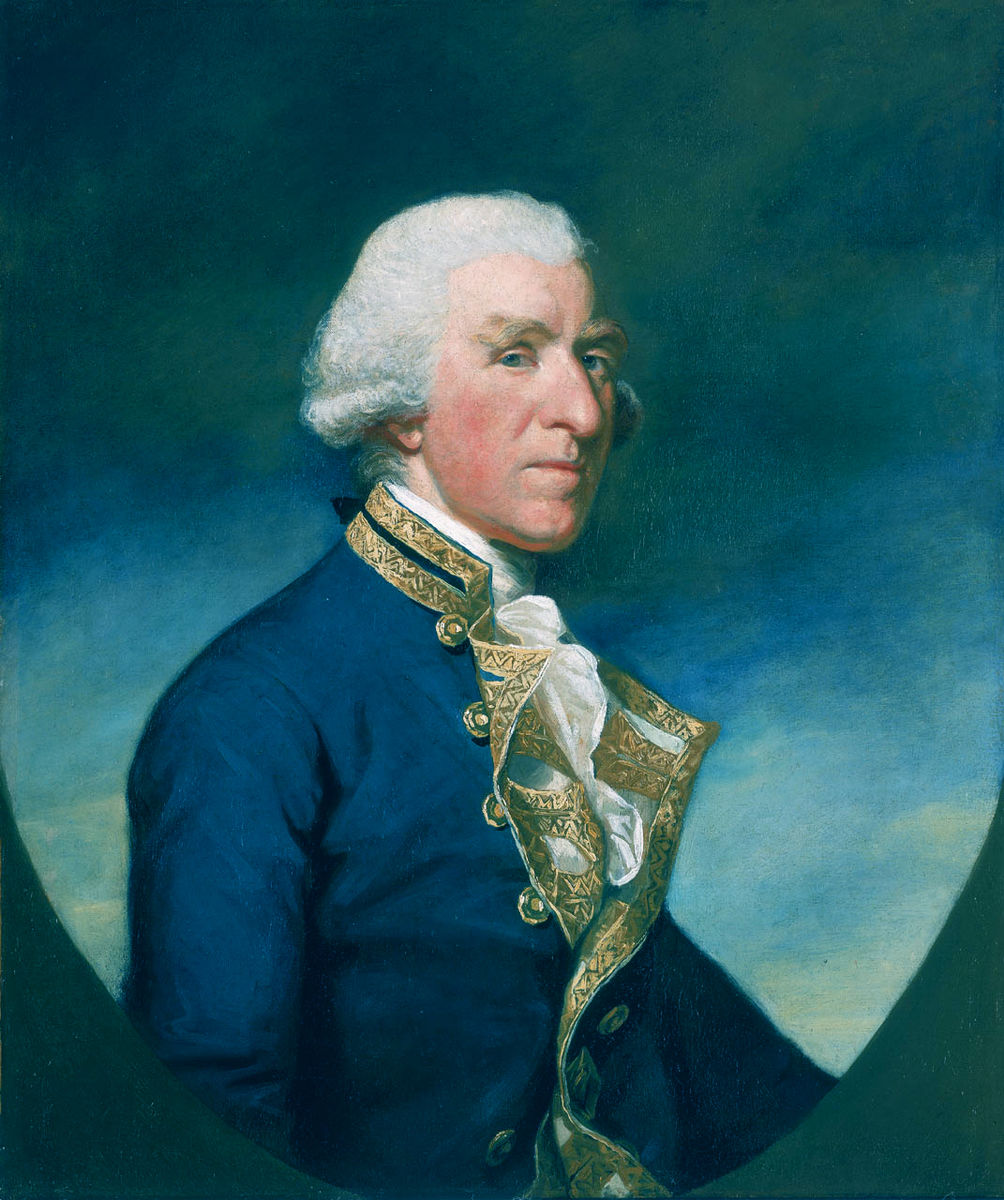
Admiral Samuel Hood, 1st Viscount Hood (1724-1816)
By James Northcote
Oil on canvas, 1784
Image : National Maritime Museum, Greenwich, London, Caird Collection
En 1797, le HMS Victory est le navire amiral de John Jervis qui triomphe lors de la Bataille du cap Saint-Vincent le 14 février 1797 en prenant l'avantage, grâce à sa maîtrise de la navigation, sur une armada largement supérieure en nombre.
Lors de cette bataille, le commandant de la frégate Minerve, un certain Horatio Nelson s'illustre par sa tactique et son courage, mais aussi par sa désobéissance aux ordres, qui conduit toutefois à la prise brillante de deux navires espagnols. Mais la destinée n'en avait pas encore fini avec Nelson…

A view of the British fleet, commanded by Admiral Sir John Jervis (1735-1823), and including the Captain (Commodore Horatio Nelson) pursuing and defeating the larger Spanish fleet, commanded by Don José de Cordova off Cape St Vincent on 14 February 1797.
John William Edy
Aquatint with etching and engraving, 1797
Image : Royal Collection Trust
Entre 1800 et 1803 le navire est en réparation.
En 1803, le HMS Victory reprend du service sous les ordres de l'amiral Horatio Nelson, commandant en chef la flotte britannique en Méditerranée. Il possède une nouvelle figure de proue (armoiries de Georges III) et de nouvelles couleurs : noir et jaune3, celles que nous pouvons observer aujourd'hui.

Proue du HMS Victory avec les armoiries de Georges III
Image : Jamie Campbell from Emsworth (nr Portsmouth), U.K (2007)
21 octobre 1805, la Bataille de Trafalgar offre une victoire britannique décisive sur la flotte franco-espagnole et devient une des batailles navales les plus importantes de l'histoire tant sur le plan historique et ses conséquences sur l'épopée napoléonienne, que sur le nombre de navires engagés. Nelson est tué par un tireur d'élite français.

The death of Lord Nelson on the quarter deck aboard HMS Victory at the battle of Trafalgar.
Coloured engraving by J. Heath, 1811, after B. West.
Image : Commons Wikimedia
De 1808 à 1812, le navire effectue diverses campagnes en Mer Baltique. Après 1824, il est retiré du service actif et positionné à Portsmouth où il reçoit le titre symbolique de navire amiral de Portsmouth.
Le 12 janvier 1922, il est placé en cale sèche à Portsmouth pour être préservé.

Le Victory à Portsmouth vers 1900
Image : Commons Wikimedia
En 1928, le navire est ouvert au public par le roi George V. En 1941, il est endommagé par une bombe allemande tombée entre la coque et le quai. Aujourd'hui le HMS Victory est la pièce maitresse du Royal Naval Museum à Portsmouth.
* Source texte et infos complémentaires : Wikipedia - HMS Victory (1765)

La nuit, la neige- Messages : 18132
Date d'inscription : 21/12/2013
 Re: Le vice-amiral Horatio Nelson, 1er vicomte Nelson, dit Lord Nelson
Re: Le vice-amiral Horatio Nelson, 1er vicomte Nelson, dit Lord Nelson
Merci pour ce post LNLN !!! 
Quelques photos de ma visite en compagnie de Lady Bess le 26 septembre dernier, et au cours de laquelle nous sommes tombés (têtes comprises ) sur maintes répliques de cette lanterne
) sur maintes répliques de cette lanterne 
Les extérieurs (pas de vues d’ensemble, elles sont toutes moches la Victory étant démâtée pour restauration) :




Quelques vues du pont et de l’emplacement où Nelson reçut le coup fatal d’un marin français (cocorico !!!
 ) :
) :


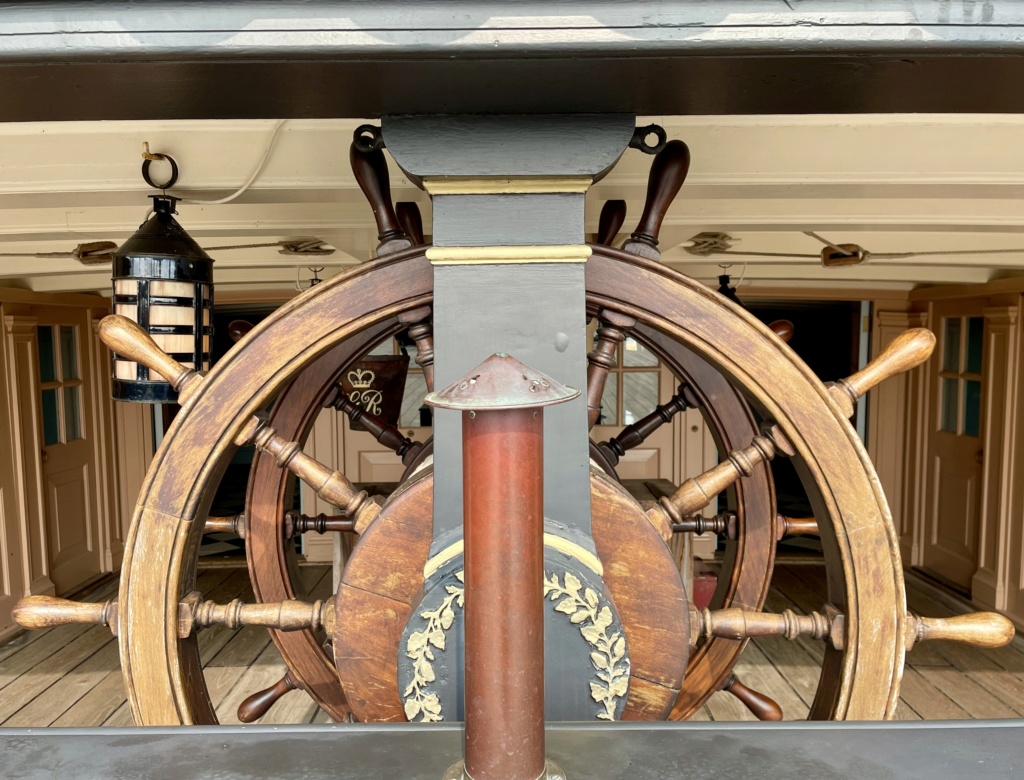


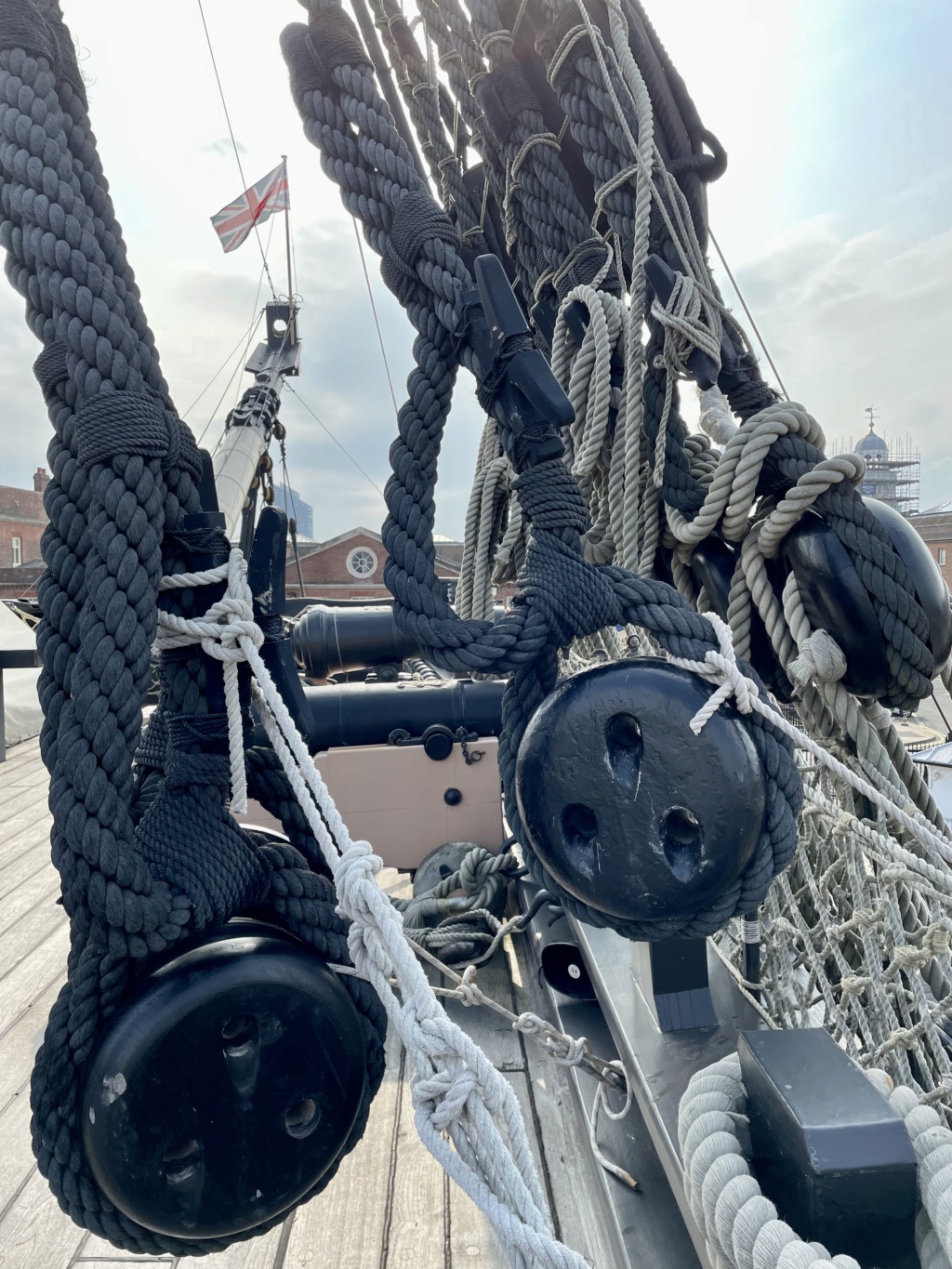

Quelques vues des ponts inférieurs :







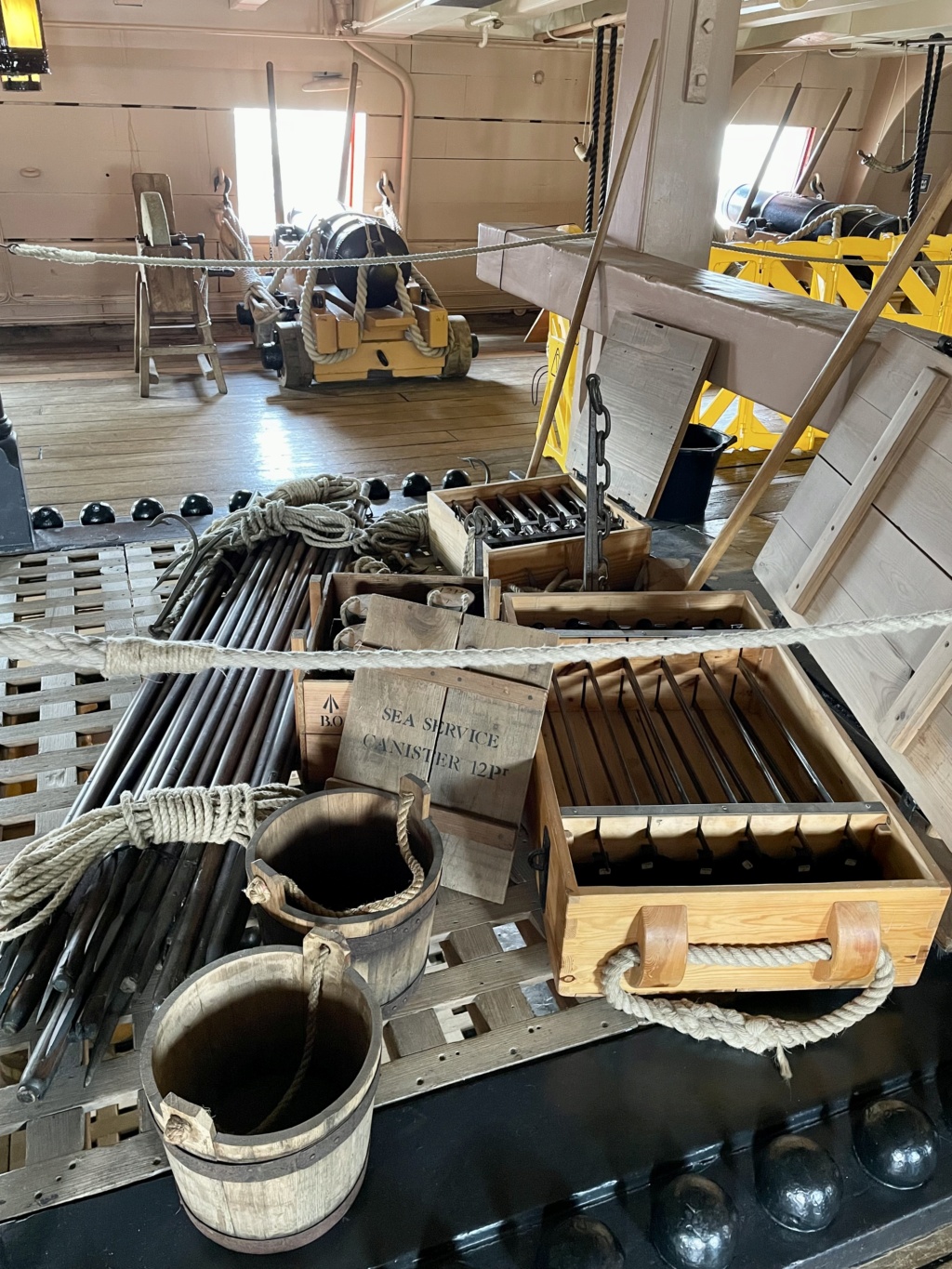

À fond de cale, la citerne d’eau, les réserves et le ballast :



L’emplacement où l’amiral rendit le dernier soupir, aujourd’hui seulement sobrement orné d’une lanterne (la mise en scène façon Tussaud de ma jeunesse a été remisée dans le musée voisin) :

Quartiers des officiers (démontables en cas de combat) dans le château arrière :





Quartiers de l’amiral dans le même château mais au niveau inférieur (sur la paroi du fond de la chambre, on distingue les portraits bien connus de Lady Hamilton et de la petite Horatia) :
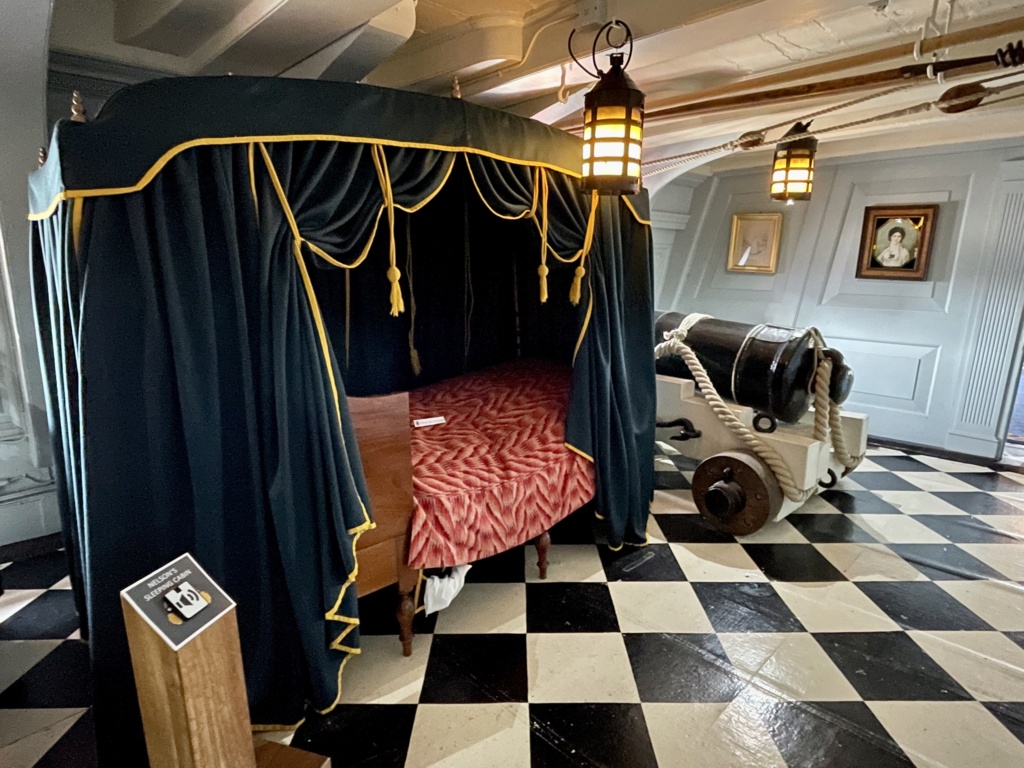



Bern moment ( ) : le cabinet de toilette, sa chaise et sa marque de fabrique
) : le cabinet de toilette, sa chaise et sa marque de fabrique  :
:


Clichés personnels

Quelques photos de ma visite en compagnie de Lady Bess le 26 septembre dernier, et au cours de laquelle nous sommes tombés (têtes comprises
 ) sur maintes répliques de cette lanterne
) sur maintes répliques de cette lanterne 
Les extérieurs (pas de vues d’ensemble, elles sont toutes moches la Victory étant démâtée pour restauration) :




Quelques vues du pont et de l’emplacement où Nelson reçut le coup fatal d’un marin français (cocorico !!!

 ) :
) :






Quelques vues des ponts inférieurs :









À fond de cale, la citerne d’eau, les réserves et le ballast :



L’emplacement où l’amiral rendit le dernier soupir, aujourd’hui seulement sobrement orné d’une lanterne (la mise en scène façon Tussaud de ma jeunesse a été remisée dans le musée voisin) :

Quartiers des officiers (démontables en cas de combat) dans le château arrière :





Quartiers de l’amiral dans le même château mais au niveau inférieur (sur la paroi du fond de la chambre, on distingue les portraits bien connus de Lady Hamilton et de la petite Horatia) :




Bern moment (
 ) : le cabinet de toilette, sa chaise et sa marque de fabrique
) : le cabinet de toilette, sa chaise et sa marque de fabrique  :
:

Clichés personnels

Gouverneur Morris- Messages : 11795
Date d'inscription : 21/12/2013
 Re: Le vice-amiral Horatio Nelson, 1er vicomte Nelson, dit Lord Nelson
Re: Le vice-amiral Horatio Nelson, 1er vicomte Nelson, dit Lord Nelson
Merci beaucoup pour ce superbe reportage photos !  Les lits " anti-roulis " me plaisent beaucoup...
Les lits " anti-roulis " me plaisent beaucoup... 
On a du mal à imaginer que plus de 800 hommes étaient à bord lorsque ce navire de guerre était en service !
La visite guidée du vaisseau, qui demeure encore officiellement le navire amiral de toute la flotte britannique, peut se faire ici :
 National Museum Royal Navy - Step on board HMS Victory
National Museum Royal Navy - Step on board HMS Victory
 Les lits " anti-roulis " me plaisent beaucoup...
Les lits " anti-roulis " me plaisent beaucoup... 
On a du mal à imaginer que plus de 800 hommes étaient à bord lorsque ce navire de guerre était en service !
La visite guidée du vaisseau, qui demeure encore officiellement le navire amiral de toute la flotte britannique, peut se faire ici :

La nuit, la neige- Messages : 18132
Date d'inscription : 21/12/2013
 Re: Le vice-amiral Horatio Nelson, 1er vicomte Nelson, dit Lord Nelson
Re: Le vice-amiral Horatio Nelson, 1er vicomte Nelson, dit Lord Nelson
My pleasure 
... et la poigne qu'il fallait à un seul homme (et quelques officiers) pour maintenir l'ordre 6 mois en mer face à 800 brutes débordant d'hormones !!!!
!!!!
Sinon le navire est immense donc le chiffre surprend moins en terme d'espace lorsqu'on le parcourt de fond en comble
J'ai oublié de souligner le revêtement de sol imitant un dallage, une sorte de papier goudronné - l'ancêtre de nos sols plastiques !

La nuit, la neige a écrit:On a du mal à imaginer que plus de 800 hommes étaient à bord lorsque ce navire de guerre était en service !
... et la poigne qu'il fallait à un seul homme (et quelques officiers) pour maintenir l'ordre 6 mois en mer face à 800 brutes débordant d'hormones
 !!!!
!!!! Sinon le navire est immense donc le chiffre surprend moins en terme d'espace lorsqu'on le parcourt de fond en comble
J'ai oublié de souligner le revêtement de sol imitant un dallage, une sorte de papier goudronné - l'ancêtre de nos sols plastiques !


Gouverneur Morris- Messages : 11795
Date d'inscription : 21/12/2013
Page 3 sur 3 •  1, 2, 3
1, 2, 3
 Sujets similaires
Sujets similaires» L'amiral Jules Dumont d'Urville ( 1790 - 1842 )
» Vice et Versailles , d'Alain Baraton
» Portraits commémoratifs et allégoriques de Marie-Antoinette
» Emma Hart, Lady Hamilton, née Amy Lyons
» Joseph-Alexandre Pierre, vicomte de Ségur
» Vice et Versailles , d'Alain Baraton
» Portraits commémoratifs et allégoriques de Marie-Antoinette
» Emma Hart, Lady Hamilton, née Amy Lyons
» Joseph-Alexandre Pierre, vicomte de Ségur
LE FORUM DE MARIE-ANTOINETTE :: La famille royale et les contemporains de Marie-Antoinette :: Autres contemporains : les hommes du XVIIIe siècle
Page 3 sur 3
Permission de ce forum:
Vous ne pouvez pas répondre aux sujets dans ce forum




